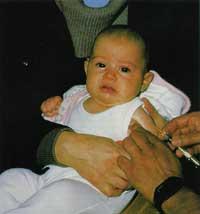Meningitis
1997/07/01 Agirre, Jabier - Medikua eta OEEko kidea Iturria: Elhuyar aldizkaria
In recent times, the media have explained to us a topic that until now was unknown to us. As a result of the decision made in February by the health authorities of the Community of Madrid (who wanted the vaccine could buy at the Residencia de la Comunidad de Madrid), thousands of people lined up to receive the meningitis vaccine. Before making this decision, in October last year, the entire population of Galicia was incorporated between 18 months and 19 years, recommended by local authorities. Suddenly, both on television and in newspapers, news about meningitis proliferated, even creating collective hysteria throughout society. Is there anything to really worry about or is it just a ghost created by fear? That is my question.

Meningitis is not just a current disease. In fact, meningitis has been in the past, it continues to exist and will continue to exist. In the late 1970s, in northern Spain, on the edge of the Bay of Biscay, an epidemic wave of meningitis occurred with very high rates. The rates of the Autonomous Community of the Basque Country (ACBC) at that time were between 15 and 20 cases of meningitis per 100,000 inhabitants, that is, in our country there were between 300 and 400 cases each year. In the last fifteen years this rate has been in continuous decline until it has been reduced to 4 cases of 100,000 and is the rate we currently have. These rates are relatively low, similar to those of the rest of Europe.
Many types of bacteria and viruses cause meningitis. Meningococcus can be noted for its serious consequences. In Meningococcus we can distinguish about 13 types, which are called alphabetically. They can be meningitis type A, type B, type W, etc. So far the most abundant type was type B, but in the last two or three years type C has been increasing, while type B has dropped. This change means that the proportional weight of serogroup C has risen above the neck of group B.
Between these two types of meningitis there is another important difference from the preventive point of view. There is no type B vaccine, but no type C vaccine. Therefore, the “million dollar question” immediately arises, whether or not to include the entire population?
Technically speaking, we should highlight that the meningitis vaccine is not yet very good. Although it has no adverse effects, the protection it gives is very reduced. In fact, among those younger than 2 years, in the most affected group, the vaccine has no protection whatsoever. In children 2 or 3 years of age, protection is 55%. Between 3 and 5 years protection can reach 70%, while in adults and older children protection exceeds 85%. On the other hand, the protection provided by the vaccine is very different, which is only maintained in people 2 or 3 years old. For these reasons, in the absence of the appearance of epidemic bids, in no case is its inclusion recommended. When 10 cases of meningitis per 100,000 inhabitants are reached, it is recommended to include everyone in this situation.
This year there have been 85 cases of meningitis: 31 in Alava, 40 in Bizkaia and 14 in Gipuzkoa (Table 1). Cases of serogroup C meningitis are 46: 19 in Araba, 21 in Bizkaia and 6 in Gipuzkoa.
The age classification shows an upward shift between older than 10 years and among adolescents an increase from the neck of serogroup C (Table 2).
In the last three months the rates of meningitis C have been different in the three Historical Territories, being always less than 10 cases per 100,000 inhabitants.
On 15 May the Advisory Council on Vaccination (Advisory Committee on Vaccinations), after studying the evolution of meningitis, recommended the inclusion of the population from 2 to 20 years in autumn. The causes were: a) the constant proliferation of meningitis C in recent years, b) the extension of the epidemic clone of the serogroup referred to in both the Basque Country and the State, c) during the month of May have not been reduced as quickly as expected, d) the usual increase of autumn disease and, finally, e) the positive experience of general vaccination in the Kayala and Valley.
The Department of Health endorsed the recommendation and the meeting held in Oviedo between 16 and 18 June with the rest of the Autonomous Communities analyzed the general strategy against meningitis C. One of the most important decisions that were made in it was the global non-integration at the state level. However, although there are no 10 cases per 100,000 inhabitants (although the rates are not high), in addition to the Basque Country, some State Associations will carry out a general vaccination in the coming fall (for example in Madrid and Extremadura).
Table . All cases of meningitis between 1 January and 30 May 1997.
| EAH 1997 | Alava | Gipuzkoa | Bizkaia | EAH |
Total cases |
Services | Security | Services | Services |
microbiological claims |
Services | Documentation | Description | More information |
| Serogroup B | Services |
Services | Other | Services |
| Serogroup C | Services | Other | Services | Services |
| Other serogroups | 0. | 1. | 0. | 1. |
without microbiological |
Services | Services | Documentation | Services |
| % C in all cases | 60.61 | 43,75 | 55.32 | 55.21 |
| % of C confirmed | 86.96 | 53,85 | 76.47% | 75.71 |
Table . Classification according to the age of confirmed cases of meningitis.
Serogroup EAH 1997 B%C Serogroup less than 2%From 426,67815,092 to 4 years 16,671324,535 to 9 years 16,67611,3210 to 14 years 16,67815,0915 to 20 years 16,671426,42120 years 746,6747,55TOTAL 1567611,5310000100,1000010000Table . Rates of Meningitis C per 100,000 inhabitants. * Between February 20 and May 20.
Alava |
4.8 |
Bizkaia |
Evolution |
Gipuzkoa |
0.4 |
CAPV |
More information |

Gai honi buruzko eduki gehiago
Elhuyarrek garatutako teknologia





